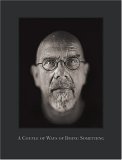Chuck Close has almost always used photographs as source material to create his artful portraits, whether in his painstakingly hyper-realistic larger-than-life paintings, or with wood-block prints, or those constructed from blobs of hand-made colored paper pulp.
He often used Polaroids to begin his work. For this project, he teamed up with daguerreotype expert Jerry Spagnoli to photograph many of his familiar subjects (artist-friends Laurie Anderson, Lyle Ashton-Harris, Cecily Brown, Gregory Crewdson, Carroll Dunham, Ellen Gallagher, Philip Glass, Bob Holman, Elizabeth Murray, Elizabeth Peyton, Andres Serrano, Cindy Sherman, James Siena, Lorna Simpson, Kiki Smith, James Turrell, Robert Wilson, Terry Winters, Lisa Yuskavage, and himself).
Then Close converted the old-world daguerreotypes into super-sharp beautiful large modern prints with high-resolution digital scans, matte black and silver inks. 19th-century meets 21st-century, with some 1950s-style beat poetry by old-school New York poet Bob Holman thrown into the mix.
The portraits hold you in their gaze. Emerging from pitch black darkness, they shimmer silvery and glowing, looming large and hazy except for a sliver of very sharp, shallow focus: perhaps only the glint of one telling eye, and a patch of shining detailed porous skin. They sear you.
Opposite each photo in the luxurious large-format book, is a lyrical “praise poem” personalized with the subject’s own words re-arranged and repeated, interspersed with the poet’s observations and musings.
The poetry is typeset in a personal, whimsical way to complement the character of each person caught willingly through the lens. Close’s unblinking stare and stunning, unrepentant, “this-is-real” detail in the prints are softened by the jazzy, boppiness of poet Holman. It’s a good pairing.
Here’s an excerpt from an interview by Kyle Rexer that is included in the book:
Rexer: “And daguerreotypes are unforgiving. In the 19th-century there were reams written about the fact that if you decided to have a daguerreotype made, you took your self-image in your hands, because nothing would be left out.”
Close: “It was more warts-and-all than any other process. Because it’s so red-sensitive, any marks, any flaws are heightened. You have to be pretty comfortable in your skin, and vanity goes out the window. And it’s also physically painful. A normal daguerreotype is a more than two-minute exposure. We’ve made it instant photography by having a billion foot-candles of light go off all at once, and that’s very painful. The flashes are so intense your eyes slam shut. It’s like having an ice pick shoved in your eyeball.
You can smell hair burning…Each one of these people who lent me their image with no control over how it’s going to come out, in this act of incredible generosity, had to put away whatever self-image they had of how they looked and accept this other image as being them. That goes beyond generosity.”
This is also Book as object. Shimmering tip-ons printed in matte black on fine silver paper grace the front and back, surrounded by the dark gray canvas hard-bound book binding. The end-papers show the front and back of one of Close’s paralyzed hands laid flat with no muscle tone at all. From beginning to end, there is no surrender.
Really, it’s an impressive book, one that you may find yourself reaching for in times of quiet reflection, or when you need a reality fix beyond looking critically into your own mirror.
—Jim Casper
A Couple of Ways of Doing Something
Photographs by Chuck Close
Poems by Bob Holman
Interview with Chuck Close and Bob Holman by Lyle Rexer
Clothbound, 22 tritone images
56 Pages, 11.375” X 14.875”
Aperture, 2006



